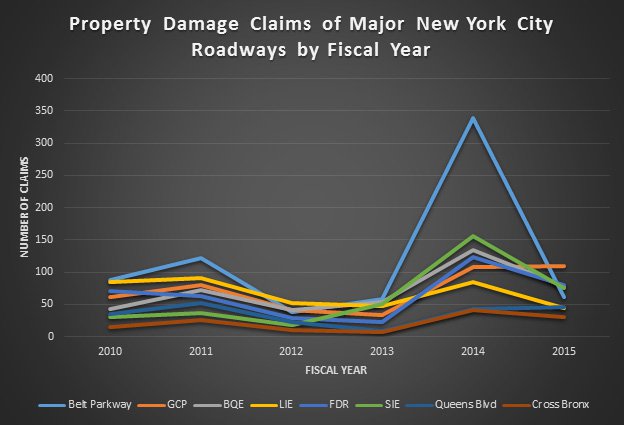Claimstat Alert: Defective Roadways Put $138 Million Hole In New York City’s Budget Over Last 6 Years
Broadway, Second Avenue and Third Avenue in Manhattan Are Biggest Problem Roadways for Pedestrians
(New York, NY)- With over 12,000 claims for damage to cars and trucks, nearly 6,000 personal injury claims, and close to $138 million dollars paid out in settlements over the past six years, New York City’s pothole problem persists, according to a new ClaimStat Alert released today by New York City Comptroller Scott M. Stringer.
“Potholes are serious trouble,” Comptroller Stringer said. “They deflate tires, break axles, and twist ankles, often at a significant financial cost to the City. The ClaimStat Alert we are releasing today gives the Department of Transportation a road map to identifying the trouble spots across all five boroughs so that they can do the important work of repairing roadways now, before winter weather comes storming back to make our City’s streets even worse.”
Potholes
The ClaimStat Alert examined the defective roadway problem on a city-wide basis, identifying the roadways that garnered the highest number of claims from FY 2010 to FY 2015.
The three worst roadways for potholes were:
- The Brooklyn-Queens Expressway, which had a total of 422 claims during the six year period;
- The Grand Central Parkway, which had a total of 433 claims during the six year period; and
- The Belt Parkway, which had a total of 706 claims during the six year period.
Trip and Fall Claims
Pedestrian-heavy Manhattan led the way in trip and fall claims, with 1,832 claims over the past six years.
The top three roadways for trip and fall claims were:
- 3rd Avenue in Manhattan, with 103 claims
- 2nd Avenue in Manhattan, with 107 claims; and
Broadway in Manhattan, with 195 claims;
Weather
Snowfall levels are a strong predictor for the volume of pothole claims. Last year’s harsh winter generated the second-highest number of defective roadway property damage claims in the last four years. The heavier snows seen in 2011 and 2014 also resulted in peak years for claims:
- In FY 2010, 51.4 inches of snow fell and 2,292 claims were filed;
- In FY 2011, 61.9 inches of snow fell and 2,823 claims were filed;
- In FY 2012, 7.4 inches of snow fell and 1,098 claims were filed;
- In FY 2013, 26.1 inches of snow fell and 1,073 claims were filed;
- In FY 2014, 57.4 inches of snow fell and 2,955 claims were filed; and
- In FY 2015, 50.3 inches of snow fell and 2,045 claims were filed.
Additional Data Points:
Comptroller Stringer’s analysis found that from FY 2010-2015 there were:
- 12,286 defective roadway claims-aka “pothole” claims – for property damage, and 1,549 settlements for defective roadway claims worth a total of $1.5 million.
- 5,913 claims for personal injuries, mostly trip and falls, related to defective roadways, and 2,681 settlements for personal injury claims worth approximately $136.3 million.
- 48 percent of those personal injury settlements were for $5,000 or less and just 7.9 percent were for more than $100,000.
Recommendations:
While DOT filled over 74,000 potholes in the first four months of FY 2015, the average time to close a pothole work order in the same time period was 6.7 days, nearly triple the 2.4 days it took in the previous year.
“The City has taken a proactive approach to improving pothole maintenance, including pothole blitzes, targeted repaving, and material enhancements, and I commend DOT Commissioner Polly Trottenberg for all of her efforts,” commented Comptroller Stringer. “However filling potholes remains an uphill battle.”
Additional steps that could be taken include:
- Exploring a complete reconstruction of certain City streets – a tactic that initially costs more than repaving, but that could save taxpayers money in the long haul;
- Continuing to pioneer the use of new and more durable materials such as rubberized asphalt and recycled plastic in road resurfacing;
- Re-evaluating DOT’s procedures to ensure that utilities properly reconstruct City streets following work that involves excavation of roadways; and
- Ensuring street repairs are completed as quickly as possible so that pedestrians don’t have to combat uneven road surfaces.
“While City streets might never be completely rid of potholes, we are working with DOT to make streets safer for New Yorkers whether they’re on two wheels, four wheels, or on foot,” Stringer said. “I applaud DOT for the great work they do, and we look forward to continuing provide them with the data they need to get ahead – and stay ahead – of New York City’s pothole problem.”
About Claimstat
ClaimStat is a data-driven tool created by Comptroller Stringer that is designed to drive down the cost of judgments and settlements by empowering City agencies to reduce claims through changes in training or resource delivery. Before suing the City in court, a claim must be filed with the New York City Comptroller’s Office. Every year, the Comptroller’s Office receives approximately 28,000 claims. Comptroller Stringer has analyzed this information to create ClaimStat reports which have examined police action claims, tree-related claims, sanitation vehicle property damage claims, playground injury claims, sewer overflow claims, correctional facility claims and pedestrian personal injury claims.
To read the ClaimStat Alert, please click here.
###


